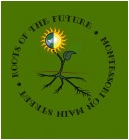"The greatest gift we can give our children are the roots of responsibility and the wings of independence .” Maria Montessori.
Montessori Framework: A child's development is the product of his or her own unique attributes, internal growth process, and external environment. Within a Montessori school setting, the tailoring process is accomplished through a combination of two means: 1) the prepared environment; and 2) freedom and limits. The goal of a Montessori school setting is to facilitate the independent development of the child by providing an environment that stimulates and unleashes the natural drives and propensities contained within every individual at birth to adapt, learn, grow, and reach one's fullest potential. To do so, the environment must make available opportunities and activities that best suit a child's stage of development.
Montessori Curriculum: The curriculum of a Montessori education incorporates the traditional subjects (reading, writing, language, mathematics, history, science, biology, geometry, geography, art, music, etc.) as well as general life skills such as self-direction, self-discipline, and self-reliance. Within the curriculum, the Montessori classroom is designed to promote multi-sensory and multi-disciplinary learning by, among other things, offering principle-based, hands-on educational tools and experiences. In contrast to the no-choice, whole-class, linear-learning approach found in most traditional schools, Montessori students are given control and choice over their work to foster interest, collaboration, and natural focus. Work, when self-directed, self-paced, and uninterrupted, enables deeper exploration in areas of particular interest, thus promoting concentration, self-discovery, and the use of a child's internal development process.
Consistent themes across lessons and work of all ages are as follows:
* Principle-based Learning: work is designed around principle-based rather than mechanical learning
* Developmentally Appropriate Activities: work offers activity types appropriate to the developmental stage of the child
* Uniform Environments and Materials: lessons, work, and classrooms incorporate elements and materials that remain
consistent, albeit with increasing complexity, as a child progresses in years
* Purposeful Work: work, whenever possible, is designed to develop skills while pursuing other practical ends
* Classroom Responsibility: work incorporates the child's responsibility for and ownership of his or her environment
Montessori Material: The material is intended to promote work, concentration, and the use of a child's internal learning mechanisms.
* Aesthetically appealing to the eye and hand
* Composed of natural materials whenever possible
* Interesting and engaging
* Designed to teach a specific concept, hone a certain skill, or serve as a resource for research
* Development stage appropriate to challenge but not frustrate or discourage the child
* Self-correcting and requiring little oversight by the teacher after the initial lesson to impart knowledge or a
certain skill
* Sequentially possessing consistent elements and the same look and feel from the younger to the older classrooms
Reference: Pedersen, H. & Pedersen, J. (2008). What is Montessori? A Basic guide to the principles, practices, and benefits of a montessori education. San Anselmo, CA: Sandpiper Press LLC.
Montessori Curriculum: The curriculum of a Montessori education incorporates the traditional subjects (reading, writing, language, mathematics, history, science, biology, geometry, geography, art, music, etc.) as well as general life skills such as self-direction, self-discipline, and self-reliance. Within the curriculum, the Montessori classroom is designed to promote multi-sensory and multi-disciplinary learning by, among other things, offering principle-based, hands-on educational tools and experiences. In contrast to the no-choice, whole-class, linear-learning approach found in most traditional schools, Montessori students are given control and choice over their work to foster interest, collaboration, and natural focus. Work, when self-directed, self-paced, and uninterrupted, enables deeper exploration in areas of particular interest, thus promoting concentration, self-discovery, and the use of a child's internal development process.
Consistent themes across lessons and work of all ages are as follows:
* Principle-based Learning: work is designed around principle-based rather than mechanical learning
* Developmentally Appropriate Activities: work offers activity types appropriate to the developmental stage of the child
* Uniform Environments and Materials: lessons, work, and classrooms incorporate elements and materials that remain
consistent, albeit with increasing complexity, as a child progresses in years
* Purposeful Work: work, whenever possible, is designed to develop skills while pursuing other practical ends
* Classroom Responsibility: work incorporates the child's responsibility for and ownership of his or her environment
Montessori Material: The material is intended to promote work, concentration, and the use of a child's internal learning mechanisms.
* Aesthetically appealing to the eye and hand
* Composed of natural materials whenever possible
* Interesting and engaging
* Designed to teach a specific concept, hone a certain skill, or serve as a resource for research
* Development stage appropriate to challenge but not frustrate or discourage the child
* Self-correcting and requiring little oversight by the teacher after the initial lesson to impart knowledge or a
certain skill
* Sequentially possessing consistent elements and the same look and feel from the younger to the older classrooms
Reference: Pedersen, H. & Pedersen, J. (2008). What is Montessori? A Basic guide to the principles, practices, and benefits of a montessori education. San Anselmo, CA: Sandpiper Press LLC.


